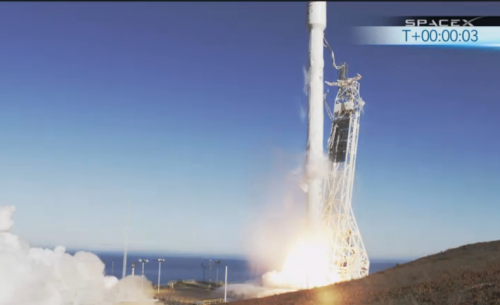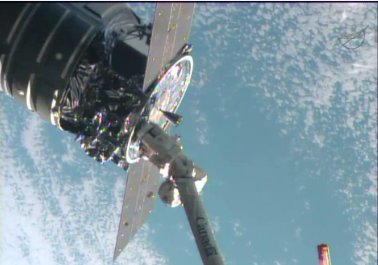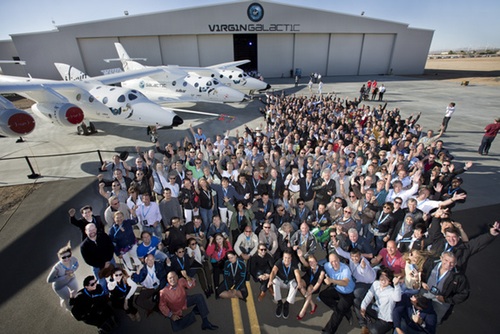|
|
SpaceX released Saturday video from the latest flight of its Grasshopper reusable launch vehicle (RLV) technology demonstrator. The flight took place on Monday, October 7, from the company’s test site near McGregor, Texas. The vehicle flew to a peak altitude of 744 meters, the highest flight yet for the vehicle, before returning to a powered landing back on pad it lifted off from. The company did not release other technical details about the flight.
SpaceX announced the flight in the somewhat quixotic manner that has become common for the company. After posting the video to YouTube earlier today, SpaceX founder Elon Musk tweeted a link to it:
SpaceX did not separately announce the test flight with a press release or other notification on its own site, instead retweeting Musk’s tweet. There was no explanation for the five-day lag in announcing the test, which was reportedly seen by some locals but not widely reported until the video was released. The test also doesn’t show up on the list of permitted launches by the FAA’s Office of Commercial Space Transportation, since the site is not being updated during the government shutdown.
While the inaugural launch of the Falcon 9 v1.1 on Sunday appeared to be successful, placing the CASSIOPE satellite and several secondary payloads into low Earth orbit, there has been some chatter over the last two days about what happened to the rocket’s second stage after it released its payloads, including speculation—now refuted by the company—that the stage exploded.
SpaceX did not in the post-launch press conference that the company had planned to relight the second stage’s single Merlin engine after deployment, but encountered a problem. “We initiated a relight and the system encountered an anomaly and did not complete the relight,” SpaceX CEO Elon Musk said in a post-launch teleconference Sunday afternoon. “We believe we understand what that issue is and should have it addressed in time for the next flight of the Falcon 9.” He said he wanted to give the company more time to investigate the issue before discussing exactly what happened. “It’s nothing fundamental.”
However, early Monday veteran space analyst Robert Christy noted something unusual: there were 20 objects being tracked in orbit from the launch. The upper stage, the satellites, and some related items accounted for many, but not all, of those items. He concluded that there had been an explosion of the upper stage. “It seems to have suffered some kind of failure after the payloads departed,” he concluded in a blog post.
That claim soon made the rounds, and by yesterday SpaceX formally responded to some media inquiries about it. “Regarding the rumors you may have heard about the Falcon 9 second stage, in short, our data confirms there was no rupture of any kind on the second stage,” a SpaceX spokesperson told Space News. She said that there was a “controlled venting” of propellants to safe the stage after payload deployment (which produced a glowing, nebulous object to some observers in the Indian Ocean region thanks to being backlit by the Sun). That venting, SpaceX believes, may have knocked loose some insulation that accounts for the additional objects being tracked.
Musk offered a similar assessment to NBC News. “During venting to safe the stage, some foil insulation on the engine came loose,” he wrote in an email. “This is very lightweight, so will quickly re-enter and burn up, but it is reflective on radar.”
Dr. T.S. Kelso of CelesTrak has also analyzed the orbits objects being tracked. That analysis, he concluded in a message to the SeeSat-L mailing list, “doesn’t seem to suggest an explosion.” However, the distribution of the objects in the orbital plane is puzzling, he admits, and could be an artifact of the recent decision by the Air Force to close its “Space Fence” tracking system.
Pop star Miley Cyrus has become famous—or infamous—for a number of things, including her performance at the MTV VMAs a few weeks ago. But in an interview in Rolling Stone magazine, she reveals something else: an interest in going in space. “I’ve always dreamed of going into space. I’m going to go at some point,” she says in a wide-ranging interview.
She’s particularly interested in going on Virgin Galactic, and claims she has an inside connection. “I’ve got a friend who invested in it, and he can kind of hook it up. I want to be one of the first ones,” she claims. It’s not clear who that friend is: Virgin has primarily been financed internally, with the exception of a stake in the company purchased by Aabar Investments of the UAE four years ago. At a current ticket price of $250,000 (not “like a billion dollars,” as she claims), she likely can afford to buy a ticket herself without the need for special connections.
In addition to her ability to afford a ticket, she also appears to have a healthy appetite for risk (both on and off the stage.) In the Rolling Stone cover story, Cyrus, among other things, goes skydiving.
 SpaceX Falcon 9 v1.1 lifts off from Vandenberg Air Force Base in California at 12 noon EDT (1600 GMT) Sunday, September 29. (credit: SpaceX webcast) As NASA was holding a press conference late this morning to discuss the successful berthing of the Cygnus spacecraft to the International Space Station, SpaceX was making its contribution to a busy commercial space Sunday. At Vandenberg Air Force Base in California, the company made final preparations for the launch of the first 1.1 version of the Falcon 9, notable for its stretched first stage and upgraded Merlin 1D engines. During the countdown webcast, company officials said all the various factors that go into a launch—the launch vehicle itself, spacecraft, range, and weather—were all green. Yet, given this was effectively a new launch vehicle, many assumed that there would be an abort at some point before liftoff.
That wasn’t the case. At 12 noon EDT (1600 GMT), at the beginning of a three-hour launch window, the Falcon 9 v1.1 lifted off the pad. Liftoff, stage separation, payload fairing separation (also a first on this mission), and second stage cutoff all appeared to go as planned. “It looks like it was a picture-perfect flight,” a SpaceX official said on the webcast, which ended before confirmation of payload separation. (There was just word that the primary payload, the CASSIOPE satellite for Canada, did indeed separate.) A post-launch press conference is expected to take place later today, but nothing official has been announced.
 Cygnus captured by the station’s Canadarm2 robotic arm. (credit: NASA TV) While it was a week later than planned, Sunday morning’s arrival of Orbital Sciences Corporation’s first Cygnus spacecraft went even better than planned. The spacecraft smoothly passed through a series of demonstrations as it maneuvered ever closer to the station. In fact, the arrival of Cygnus went so smoothly the capture of the spacecraft by the station’s Canadarm2 robotic arm took place 15 minutes ahead of schedule, at 7:00 am EDT (1100 GMT). There was one drawback to that efficiency: the capture took place during a gap in live video coverage, which meant early risers in North America who got up to watch the capture on NASA TV instead saw a computer animation driven by telemetry until video came back a couple minutes later!
The arm is now moving Cygnus into position to be berthed to the station Harmony node, which should take place around 9 am EDT (1300 GMT) Sunday. (Update: berthing also took place a little ahead of schedule, at 8:44 am EDT (1244 GMT). And, as it turns out, that berthing also took place during a gap in live video coverage.) Hatches between Cygnus and the station are slated to open on Monday. A press conference at 1 pm EDT (1700 GMT) on NASA TV should offer more details about the capture and berthing.
Yesterday, Sir Richard Branson blogged about Wednesday’s Virgin Galactic customer event in Mojave, where several hundred future Virgin astronauts got to hear about the progress the company has made and future plans but, due to winds, not see a test flight of SpaceShipTwo. (Interestingly, Branson’s post says about 300 customers attended the event, while the Virgin release said “approximately 400.”) “The excitement in the room was palpable as us future astronauts imagined where the journey might take us,” Branson wrote in his post.
What’s more interesting, though, is what you won’t find in that post now. When it was originally published yesterday, Branson said that attendees also got to witness a test of a liquid-propellant rocket engine, a test that created “a piercing light flashing across the barren desert landscape.” Since SpaceShipTwo uses a hybrid rocket engine, this engine presumably is one under development for the company’s LauncherOne small satellite launch vehicle, which the company previously said will use liquid oxygen and kerosene propellants. However, that brief passage is no longer in the post: there’s no mention at all of any engine test during the event. Doug Messier, who was in Mojave but not at the Virgin event that day, reported there appeared to be a 15-second engine test, but he could neither hear nor see it from his vantage point.
Meanwhile, Branson dropped a hint that there’s something else, perhaps, going on at Virgin with respect to low-cost human spaceflight. In a brief interview with Business Insider (see video below), he says he hopes to eventually bring the cost of flying on SpaceShipTwo down. “I think in the next ten years it’s going to be quite expensive,” he said, but that they will eventually be able to bring the price down “quite considerably.” That much, at least, is in line with past comments by Virgin officials.
Branson, though, then springs a surprise. “We do have another idea, which we’re going to announce in about four months’ time,” he said, “which will enable people to travel up to space very cheaply—not everybody, but quite a few people who never expected to go to space. We’re going to unveil that in about four months’ time.” Pressed for details, Branson demurred. “I always say too much. I’ve already said too much.” Whether this is a technological innovation or a financial one (such as a means to finance the now-$250,000 ticket price) remains to be seen.
Sunday is shaping up to be a particularly big milestone for commercial spaceflight. On Thursday, Orbital Sciences announced it is now planning a second attempt to berth its Cygnus cargo spacecraft with the International Space Station in the early morning hours of Sunday. Assuming its plans are approved by NASA, Orbital will command Cygnus to gradually approach the space station in the early morning hours of Sunday; an exact timeline of events has not yet been released. Orbital originally planned to have Cygnus arrive at the station last Sunday, but that approach was aborted because of a software glitch. Orbital noted in its latest update that the problem was fixed with just one line of code.
That berthing will be followed just hours later by the first launch of the Falcon 9 v1.1 from Vandenberg Air Force Base in California. Base officials confirmed Wednesday that the launch is scheduled for 9 am PDT (12 pm EDT, 1600 GMT) Sunday. The Air Force release didn’t indicate how long the launch window was, but a local newspaper, the Lompoc Record, said it would be open for three hours. If Sunday’s launch is scrubbed, there will be another opportunity on Monday, Elon Musk tweeted on Wednesday.
Those two events make for a busy Sunday morning, but the good news is that if they take place on schedule, they’ll be done in time for Sunday afternoon’s slate of NFL games and the final day of the MLB regular season…
 Attendees at Virgin Galactic’s customer event in Mojave Wednesday didn’t see SpaceShipTwo fly, but did at least get a group photo with Sir Richard Branson. (credit: Mark Greenberg/Virgin Galactic) For months, there had been speculation about what Virgin Galactic might do at an event for its customers in Mojave in September. An engine test firing? A glide flight of SpaceShipTwo? A powered SpaceShipTwo test flight? Virgin has a reputation for putting on a show at its events, and this was expected to be no exception.
As it turned out, plans did call for a glide flight of SS2, but no such flight took place. Doug Messier at Parabolic Arc reported that gusty winds kept SS2 and its WhiteKnightTwo carrier aircraft on the ground Wednesday, much to the disappointment, no doubt, of the several hundred people who traveled from around the country and beyond for the event. Messier reports that there apparently was an engine firing at a Virgin test site at Mojave, but he could not see or hear anything from his distant vantage point.
The scrubbed test flight was confirmed by the handful of media who were in attendance at the event itself. “We really wanted to do a special spaceship flight for you today,” Virgin Galactic CEO George Whitesides said, in a Discovery.com account of the event. “We gave it our all, but in the end weather just didn’t cooperate.” He said the decision to scrub the flight was further evidence of the company’s commitment to safety.
(While it was common knowledge that Virgin Galactic was holding an event for its customers in Mojave this week, the company did not publicize it in advance, nor send out any broad set of invitations to the media. However, they apparently did invite a select few to attend, as, in addition to Discovery.com, Time was there, as was CNN and even the Bakersfield Californian. Companies have every right to play media favorites at an event like this, of course, and in the end, they didn’t get much more than some human interest stories out of the trip.)
Virgin Galactic’s press release about the event, issued apparently while the event was ongoing (it features a mix of past and future tense descriptions of the day-long event), makes no mention of the scrubbed test flight. Instead, it release played up the near-term prospects for commercial flights by SpaceShipTwo, which company officials have previously said they expect to begin next year. “With supersonic powered test flights of SpaceShipTwo well underway, a full commercial service is fast approaching. In fact, today’s event could well be the last major gathering of future astronauts before we finally start to make their dreams of space travel a reality,” Sir Richard Branson said in the release. And attendees did get to see “a stunning showcase of SS2 cabin seat prototypes,” according to the release, so there’s that.
And if any of the 640 attendees, including 400 customers (according to the Virgin release) are complaining about the wind keeping SS2 grounded yesterday, keep in mind yesterday was not the windiest Virgin Galactic event in Mojave. Not even close.
You might have seen a surprising revelation in the news in the last few days: William Shatner, the actor best known as Captain James T. Kirk from the Star Trek franchise, turned down an opportunity to fly on Virgin Galactic because… he’s afraid of flying? It generated headlines around the globe, primarily in tabloids and celebrity gossip publications. But, you shouldn’t be surprised, since the news, well, isn’t news.
This “news” apparently had its origins in a talk Sir Richard Branson gave last week, and picked up by the UK tabloid The Sun. However, since The Sun’s article is behind a paywall, most people saw references to it elsewhere, such as the Daily Mail and The Star. The gist of those reports: Shatner turned down an offer to be among the first Virgin Galactic passengers because he’s afraid of flying.
While those and other publications treated that as a new revelation, it’s something Shatner himself has been saying for years. “I don’t like to vomit,” Shatner said in 2007, referring to a zero-g airplane flight but also expressing his lack of interest in spaceflight. “I’m interested in man’s march into the unknown but to vomit in space is not my idea of a good time. Neither is a fiery crash with the vomit hovering over me,” he said back in 2006. His views clearly haven’t changed, but few, if any articles, reached any farther back than similar comments Shatner made in 2011.
Remember, just because it’s in the news doesn’t mean that it is news.
All had been going well for Orbital Sciences Corporation’s Cygnus spacecraft since its launch Wednesday on the company’s Antares rocket. The mission, though, hit a snag Sunday, when Cygnus made contact with the ISS and received data from it. There was a “data format discrepancy,” in the words of an Orbital statement, between the data received from the station’s navigation system and what Cygnus was programmed to receive, so Sunday’s arrival was scrubbed and rescheduled for Tuesday.
On Monday, the company said that while they had developed and tested a software fix to resolve Sunday’s glitch, they were postponing the next attempted rendezvous until Saturday. This time, it’s not a problem with Cygnus itself. Instead, a Soyuz spacecraft, carrying three new ISS crewmembers, is scheduled for launch just before 5 pm EDT (2100 GMT) Wednesday, docking with the station less than six hours later. That “resulted in a tight schedule to the point that both Orbital and NASA felt it was the right decision to postpone the Cygnus approach and rendezvous until after Soyuz operations,” NASA said in a statement. Arrival is now planned for no earlier than Saturday; an exact schedule will come after the Soyuz arrives at the station.
|
|




Recent Comments